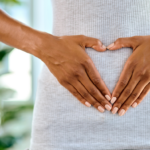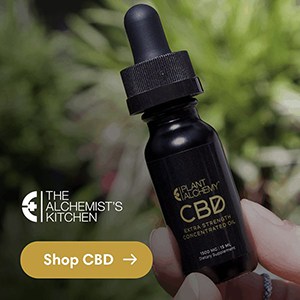To truly know which herbs are helpful during the transitional time of menopause, we must first understand what processes are happening in the body. Generally, as folks assigned female at birth (AFAB) reach their late forties and early fifties, their ovaries—which have, since puberty, been producing estrogen and releasing an oocyte, or immature ovum, each month—begin to lose their reserve of estrogen and responsive, viable oocytes. This causes a cascade of hormonal changes, most notably, a decrease in estrogen production. Menopause can begin earlier or later, especially if a person is taking synthetic hormones or has undergone surgery, such as a bilateral oophorectomy, or removal of the ovaries. Menopause, by definition, has been reached once menstruation has ceased for a full year (sometimes called ‘perimenopause’); the shifts and symptoms experienced before and after this are called pre- and post-menopause, respectively. But everyone experiences menopause differently because, of course, everyone has a different body!
It’s important to remember that while menopause has been largely demonized and feared—like most natural processes of AFAB bodies—it marks a time of huge transition and transformation in a person’s life, and should be seen and celebrated as a sacred passage. Our Western society worships the youthful and new in an unbalanced way, but nearly all known indigenous cultures revere their elders, and consider it an honor to become one. Similarly, the unpleasant symptoms of menopause are not an unavoidable curse, and it is possible to alleviate them. These symptoms often include estrogen-related hot flashes, night sweats, decrease in bone density, mood swings, vaginal dryness and atrophy—all of which can be addressed with herbs, nutrition, and lifestyle adjustments.
Sage, Salvia officinalis
Sage is one of those “friendly” herbs most folks are already familiar with, especially in a culinary context. While Sage has many uses—including as a carminative or digestion-aiding herb—it has long been synonymous with healthy aging. We often refer to wise elders as “Sages” and there are many Old English proverbs like, “Why should a man die whilst sage grows in his garden?” Sage is a tried-and-true remedy for menopausal symptoms like hot flashes, heavy menstruation, and brain fog. In one clinical study, a fresh preparation of cool Sage tea taken 2-3 times per day, 3-4 days per week was proven to be effective in the treatment of hot flashes and associated menopausal symptoms. Alternately, about 30 drops of Sage tincture can be taken in place of tea if making tea isn’t an accessible option. In another clinical study, Sage tea successfully treated the majority of participant hot flashes, showed significant sweat reduction, and was reported to have positive effects on the nervous system, including improved memory.
St. John’s Wort, Hypericum perforatum
Change in temperament is another major menopausal complaint is; many menopausal folks report becoming more irritable and experiencing unpredictable mood swings. St. John’s Wort can be an invaluable herb for stabilizing mood and improving menopausal symptoms of an emotional, psychological, or psychosomatic origin. One 1999 study found that taking 900 mgs of St. John’s Wort in capsule form three times daily alleviated nearly 80% of participants’ symptoms completely. This study also found that the St. John’s Wort supplementation improved overall sexual wellness and significantly reduced hot flashes. St. John’s Wort is not for everyone, however, and should be avoided by those taking pharmaceuticals due to its stimulation of certain enzymes in the liver that may increase or decrease the effectiveness of medication. Supporting liver function is very important during menopause, as the liver is under a lot of metabolic, hormone-related stress. As an alternative to St. John’s Wort, consider supplementing with Milk Thistle or DIM.
Red Clover, Trifolium pretense
For several reasons, Red Clover is an indispensable herb for menopause. Red Clover contains isoflavones, a type of phytoestrogen, which are plant-based estrogens uptaken by the body as its own hormones. Because the body’s own production of estrogen decreases during menopause, it can be helpful to introduce phytoestrogens to offset severe symptoms, like debilitating hot flashes, night sweats, and bone density loss. A recent Danish study found Red Clover to be extremely effective in reducing both the occurrence and severity of hot flashes and bone density loss. Red Clover is a great alternative to pharmaceutical Hormone Replacement Therapy (HRT) which uses synthetic estrogens and can cause several undesirable side effects. Red Clover is also wonderfully nutrient rich and helps to protect the cardiovascular and immune system. Red Clover should be avoided by anyone on HRT or birth control, anyone who has had hormone related cancers, or anyone with blood clotting disorders. Those taking pharmaceuticals should check with their doctor before taking Red Clover. Comfrey and Nettles are alternative nutrient rich herbs that do not contain phytoestrogens and would be beneficial in promoting bone density in menopausal people.
Black Cohosh, Actaea racemosa
Similar to Red Clover, Black Cohosh has phytoestrogenic effects in the body, and is effective in treating menopause symptoms like night sweats, hot flashes, insomnia, osteoporosis, irritability, heart palpitations, and headache. In a three-part German study, 80 menopausal women were treated with Black Cohosh extract, conjugated estrogens, or a placebo. Women in the Black Cohosh group reported improvements in anxiety; menopausal complaints such as mood swings and irritability; and vaginal symptoms such as dryness and loss of tissue. In addition, the number of hot flashes dropped from 5 to less than 1 average daily occurrences in the Black Cohosh group compared to the group taking estrogen, which reported hot flashes dropped from 5 to 3.5 daily occurrences. In a 2005 study comparing Black Cohosh to low-dose transdermal estradiol, both were found to significantly reduce the number of hot flushes and vasomotor symptoms per day, within the first month of treatment, and for up to 3 months. Anxiety and depression were also notably lessened. In multiple studies, treatments with both synthetic hormones and Black Cohosh became less effective after 3 months, after which it becomes beneficial to titrate off of either HRT or estrogenic herbs. This is generally the time it takes the body to find hormonal balance again. Like Red Clover, Black Cohosh should be avoided by anyone on HRT or birth control, anyone who has had hormone related cancers.








